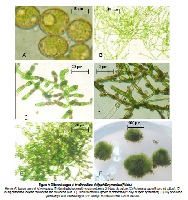In vitro culture of the moss Hyophilla nymaniana (Fleish.) Menzel and its phytochemical screening
Keywords:
Hyophilla nymaniana (Fleish.), Menzel, in vitro culture, sodium hypochlorite, MS mediumAbstract
Bryophytes are the second largest group of land plants after angiosperm and are considered as a remarkable reservoir of many new, natural products or secondary metabolites, which have shown interesting biological activity. The full economical potential of bryophytes is not completely explored. The present study aims to establish an efficient protocol for in vitro culture of one of the species of moss Hyophilla nymaniana (Fleish.) Menzel and to perform phytochemical screening of this moss. Media content as well as light and temperature were varied to get the optimum condition for spore germination. Maximum number of spore germinated in 1/4 strength MS containing 1.5% sucrose and 2% of NaOCl was found to be the best for surface disinfection of sporophyte. Temperature range of 22±1 ͦC and pH 6 along with light intensity of 2000-4000 lux with alternate day and night condition of (16/8 hours) was found suitable for the growth of the plant. For phyotochemical screening the methanolic ethanolic and ethyl acetate extract of the moss prepared. Ethanolic extract showed the presence of alkaloids, glycosides, steroids and terpenoids.
References
Hallingback T, Hodgetts N. Mosses, liverworts and hornworts; status survey and conservation action plan for bryophytes. IUCN/SSC Bryophyte Specialist Group- Oxford Biotech. 2000; 18: 393-398.
Gradstein SR, Churchill SP, Salazar AN. Guide to the Bryophytes of Tropical America. Mem. N.Y. Bot. Gard. 2001; 86: 1-577.
Crum H. Structural Diversity of Bryophytes. University of Michigan Herbarium, Ann Arbor. 2001. p. 379.
Asakawa Y. Biologically active substances from bryophytes: Bryophyte development: physiology and biochemistry. In: Chopra RN, Bhatla SC editiors.CRC Press, Boston, 1990. p. 259-287.
Frahm JP. Recent development in commercial products from bryophytes. Bryologist. 2004; 107(3): 227–283.
Nath V, Asthana AK. Potential bryophytes–utility and future prospects. Appl Bot Abstr. 1995; 15(3): 205–215.
Singh M, Govindarajan R, Nath V, Rawat AKS , Mehrotra S. Antimicrobial, wound healing and antioxidant activity of Plagiochasma appendiculatum Lehm. et Linden. J Ethnophar-macol. 2006; 107: 67–72.
Mues R. Chemical constituents and biochemistry in Bryophyte biology. In Shaw AJ, Goffinet B editors. Cambridge University Press, 2000. p. 150-181.
Sabovljevic M, Bijelovic A, Grubisic D. Antimicrobial activity of Bryum argentums. Fitoterapia. 2006; 77:144-145.
Bijelovic A, Sabovljevic M, Grubisi D, Konjevic R. Phytoharmone influence on the morphogenesis of the mosses Bryum argentenum (Hedw.) and Atrichum undulatum (Hedw.) P. Beauv). Israel J Plant Sci. 2004; 52: 31-36.
Sakai K, Ichikawa T, Yamada M, Tanimoto M, Hikita A, Ijuinand Y and Konodo K. Antitumor principles in Mosses: The first isolation and identification of Maytansinoids, including a novel 15- Methoxyansamitocin P-3. J. Nat. Prod. 1988; 51: 845-850.
Decker EL, Reski R. Moss bioreactor producing improved biopharmaceuticals. Curr. Opin. In Biotech, 2007; 393-398.
Murashige T, Skoog FA. Revised medium for rapid growth and bioassay with tobacco tissue culture. Physiol Plant. 1962; 15:473–496.
Reski R, Abel WO. Induction of budding on chloronemata and caulonemata of the moss, Physcomitrella patens using isopentenyladenine. Planta. 1985; 165: 354-358.
Trease GE, Evans WC Pharmacognosy, 11th edn., Bailliere Tindall, London,1989. p. 45-50.
Sofowora A. Medicinal Plants and Traditional Medicine in Africa. 2nd Edition, Spectrum Books Ltd., Ibadan, 1993. p. 81-85.
Vujicic M , Sabovljevic A, Sabovljevic M . Axenically culturing the bryophytes: a case study of the moss Dicranum scoparium Hedw. (Dicranaceace, Bryophyta). Botanica Serbica . 2009; 33(2): 137-140.
Awasthi V, Nath V and Asthana AK. In vitro Study and Micropropagation of Ethnomedicinally Important Bryophyte: Plagiochasma appendiculatum Lehm. & Lindenb. Proc. Natl. Acad. Sci., India, Sect. B Biol. Sci. (July–September 2012) 2012; 82(3):405–412.
Schofield WB: Ecological significance of morphological characters in the moss gametophyte. Bryologist. 1981; 84: 149-165.



